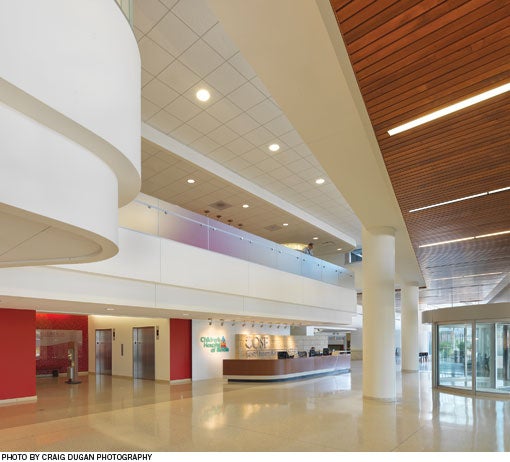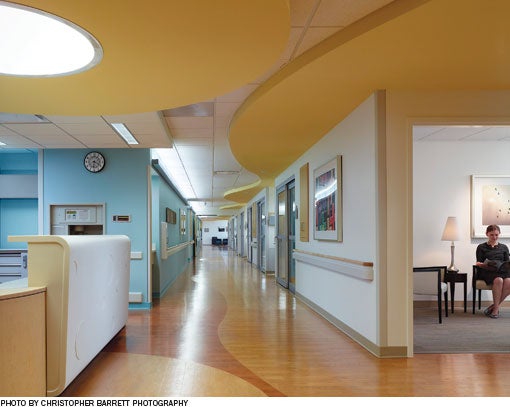Major milestone

Project Overview
Project Name Children's Hospital of Illinois and OSF Saint Francis Medical Center
Location Peoria, Ill.
Total floor area 440,000 square feet
Number of floors 10
Number of beds 215
(60 neonatal intensive care beds; 32 pediatric intensive care/critical care beds; 32 general pediatrics beds; 32 adult cardiology beds; and 55 emergency department beds, plus 2 triage and 2 trauma beds)
Project cost $280 million
Construction cost $200 million
Groundbreaking date July 2007
Opening date August 2010
Project Team
Owner OSF HealthCare
Architect Cannon Design
Associate Architect for Pediatric Design Stanley Beaman & Sears
General Contractor Mortenson Construction
Interior Designer Cannon Design in association with Stanley Beaman & Sears
MEP Engineering KJWW Engineering Consultants
Structural Engineering Thornton Tomasetti
Medical Equipment Planning Mitchell Associates
Landscaping Hitchcock Design Group
Civil Engineering Hanson
Signage Stanley Beaman & Sears
The design and construction of expanded facilities for the Children's Hospital of Illinois and OSF Saint Francis Medical Center, Peoria, was such a significant development at the hospital that it was known as the Milestone project.
The project was an opportunity to remedy several facility issues, including bringing Children's Hospital of Illinois, which was officially established within OSF Saint Francis Medical Center in 1990, under one roof. "Children's Hospital was fragmented, with services in multiple buildings. The whole patient experience needed to be addressed," says Sue Wozniak, FACHE, who was the organization's chief operating officer (COO) throughout the Milestone project.
The 440,000-square-foot facility expansion includes a new lobby with convenient outpatient care, new emergency and surgery departments, and new units for cardiovascular procedures, adult cardiac care, neonatal intensive care, pediatric critical care and general pediatrics. There is also a shelled floor for future use.
In addition to consolidating services, the expansion project enabled the hospital to improve access and wayfinding, implement new technology and care models, and increase the capacity, safety and flexibility of the Level 1 trauma center and tertiary care medical center.
Building blocks
The new facility establishes a clear entry sequence that begins as people approach the medical center from Interstate 74, which runs along the west side of the campus. From this perspective, the facility can be seen as an abstract composition of colored children's blocks. The modern design fits with existing campus structures, but provides subtle cues that this building is something different, says Randy Guillot, AIA, LEED AP, design principal, from the Chicago office of Cannon Design.

The new addition is attached to a parking garage by an enclosed pedestrian bridge that links to the existing hospital. A secondary reception point at the entrance to the pedestrian bridge helps direct people to their correct destination. The pattern of the terrazzo flooring also is designed to lead patients and visitors down a daylit corridor to the new lobby. Bold splashes of color provide wayfinding landmarks throughout the building. "It's a very deliberate sequence that tries to take away some of the anxiety of not knowing where you're going," Guillot says.
Something for everyone
The lobby features a glass sculpture based on St. Francis of Assisi's Canticle of the Sun, which is used as a theme throughout the hospital design.
Enclosed admitting and registration booths in the lobby ensure patient privacy. A centralized diagnostic services area puts such common outpatient services as electrocardiograph testing and the laboratory in one location. A family resource center provides office, kitchen and laundry facilities for those whose family members are hospitalized for long periods.
The lobby includes a special waiting area for children. Here, an enclosed interactive media system allows projected images to be manipulated digitally as if by magic. Burn Sears, AIA, principal-in-charge for Stanley Beaman & Sears (SBS), Atlanta, associated architect for pediatric design, notes the system's projectors are mounted in the ceiling, rather than on the wall, to provide patients in wheelchairs the opportunity to interact with the images — for instance, to roll through and scatter a pile of leaves projected on the floor.
Child-height design features take advantage of children's unique perspective on the world. Young children can peer through the circular elements in the decorative glass near the gift shop and family resource center. Columns along the concourse of the admitting and diagnostic services waiting areas are wrapped in solid-surface wall panels with raised images of animals. These are not overt in the environment, but are there for discovery by kids, explains Jocelyn Stroupe, IIDA, AAHID, EDAC, interior designer, Cannon Design.
"We tried to select design elements that were appealing to both children and adults," says Wozniak.
'Best of both worlds'
In the new surgical department, a child life playroom and separate waiting and preoperative/recovery rooms for adults and children ensure that the needs of both patient populations are addressed. "But the expensive aspects of the surgery are shared — the technical aspects. So we've got the best of both worlds," Wozniak says. There are four heart surgery suites with adjacent cardiac catheterization laboratories for adult and pediatric patients, and three specialized pediatric operating rooms.
Operating room temperature control is calibrated to provide the best environment for different procedures. The temperature of the pediatric operating rooms can be raised to 90 degrees in 10 minutes; in the heart surgery suites, it can be dropped to 60 degrees in 15 minutes. Many such safety features, including patient lifts and separate adult and pediatric pharmacies, are included in the new facility.

On the patient units, the rooms are designed for any acuity level. The hospital currently draws critical care patients to most of its services, but "health care is in flux. We don't know if that will change over time," Wozniak says. Every new patient room — including adult and neonatal intensive care — is private, has its own bathroom and contains overnight accommodations for family members. Private sleep suites on the neonatal intensive care unit give parents a place to take an extended break, says Bessie Stephenson, program manager, SBS.
Conscious decisions
According to Guillot, the medical center leadership was conscious of how every design decision would affect the lives of people who use the building. With a project of this scope, says Wozniak, "you'd better be making positive change."
The project was somewhat of a personal milestone for Wozniak, who retired as COO shortly after the new building opened. She says it was a great way to end her career as a health care executive, and that with the new facility the medical center is "absolutely, no question" serving patients better.
Amy Eagle is a freelance writer based in Homewood, Ill., who specializes in health care-related topics. She is a regular contributor to Health Facilities Management.
| Sidebar - Catholic identity woven into interior design |
| Every major health care facility needs an organizing principle to assist with wayfinding and unify the design. At Children's Hospital of Illinois and OSF Saint Francis Medical Center, Peoria, the Canticle of the Sun, written The medical center is a large, Catholic institution that serves children and adults. "We wanted that Catholic identity to be woven into the building," says Sue Wozniak, FACHE, who recently retired as the hospital's chief operating officer. The Canticle of the Sun has particular meaning to the Sisters of the Third Order of St. Francis, the religious order that owns and operates OSF HealthCare, of which the new medical center is a part. In the canticle, the hospital's patron saint sings praise for various aspects of creation, such as "Brother Sun," "Sister Moon" and "Mother Earth." A major art piece in the lobby introduces the canticle; each floor of the new building is assigned to one of the natural elements the canticle celebrates. These elements are represented in icons used to identify floors on hospital signage and in artwork displayed on each floor. Use of the canticle throughout the building infuses the organization's religious mission into the facility in a way that connects with nature and has universal appeal. The theme is engaging to children and provides an educational component, but is also meaningful to adult patients, visitors and staff. "In health care design, bringing in elements of nature is considered to be a good strategy to employ," says Jocelyn Stroupe, IIDA, AAHID, EDAC, interior designer, Cannon Design. "But this, we felt, really had such a deeper significance. It just fit the overall building so well. It was a unique opportunity to weave something like that into a project." |
| Sidebar - ED design accentuatesdisaster-ready flexibility |
| The new emergency department (ED) at Children's Hospital of Illinois and OSF Saint Francis Medical Center, Peoria, is designed to provide optimal patient care in both ordinary and extraordinary circumstances. Waiting areas and clinical work areas are completely separate in the ED, for a quieter, more organized environment. Each treatment bay has two doors, one leading out to a ring of subwaiting areas for people who are accompanying patients, and one on the opposite wall leading to centrally located clinical work stations. A keycard lock system provides extra security for the treatment bays. Pediatric and adult patients are treated along different tracks, in a design that allows these areas to expand or contract according to the patient census. A third track for trauma patients includes treatment rooms that are nearly 500 square feet and fitted with two headwalls each, so they can be used to treat multiple patients. Imaging and computed tomography equipment is nearby. Because the medical center is the Level I trauma center for Region 2 of the state of Illinois, the capacity of the ED — which is 57 patients during normal conditions — is designed to surge to almost 100 patients in response to a disaster. Headwalls are hidden behind artwork in the subwaiting areas to allow the hospital to use these spaces for patient care, if needed. The staff work areas also can be used to stage blunt-trauma patients. To handle biohazards or infectious diseases, one section of the department can be locked down and segregated onto a bypass mechanical system that creates negative air pressure. The adjacent, former ED can also be pressed into service for patients, if necessary, and the hospital's hillside site includes room for multiple air and ground emergency transport vehicles. In one space, "we really designed two emergency departments, for two completely different uses," says David Kuffner, AIA, senior planner, Cannon Design. |
| Sidebar - SPEC SHEET |
| Principal Design Acoustical wall panels: Decoustics with Carnegie fabric Acrylic panel: 3form and Knoll Inc. Carpet tile: InterfaceFLOR, J+J/Invision and Mohawk Carpet Ceiling: Decoustics, Ecophon, Rulon Co. and USG Corp. Curtainwall framing: Architectural Wall Systems and Sota Glazing Inc. Door hardware: Dorma, Ingersoll Rand Security Technologies, Kaba, National Guard Products and Rockwood Manufacturing Co. Flooring: Altro, Johnsonite, Mannington Mills Inc., Nora Systems Inc., Shaw and Terrazzo & Marble Supply Companies Glass doors: Virginia Glass Products Corp. Glass: McGrory Glass Inc., Oldcastle Inc. and Skyline Design Headwall panels: Marlite Lighting: Celestial Lighting, Eureka, Litecontrol, Litelab Corp., Lithonia Lighting, Gotham Architectural Downlighting, Healthcare Lighting, Precision Architectural Lighting Inc., Philips Color Kinetics and Resolute Lighting Operable partitions: Kwik-Wall Moveable Wall Systems Paint: Benjamin Moore & Co. and Scuffmaster Plastic laminate: Formica Group and Wilsonart International Plumbing accessories: American Specialties Inc. Plumbing fixtures: American Standard, Chicago Faucets, Elkay Companies and Zurn Industries Roofing: Versico Inc. Signage: ASI Sign Systems Inc. Solid surface: DuPont Stone wall: Vetter Stone Co. Tile: Daltile and Stone Source (glass tile) Walk-off mat: Construction Specialties Inc. Wall coverings: Designtex, Maya Romanoff Corp. and MDC Wallcoverings Wall protection: InPro Corp. Window treatments: MechoShade Systems Inc. Wood doors: Marshfield DoorSystems Inc. Wood panels: Dooge Veneers Inc. and Interlam Inc. Principal Furnishings Casework and woodworking: Stevens Industries Inc. Lounge seating: First Office, Loewenstein and Nemschoff Office desks and seating, files and shelving: Herman Miller Inc. Patient room seating: KI, Nemschoff and Sauder Manufacturing Co. Major medical equipment Exam lights/operating room booms: Berchtold Headwalls: Modular Services Co. Imaging equipment: GE Healthcare, Philips Healthcare and Siemens Healthcare Operating room integration: Stryker Patient lifts: Liko Infrastructure Building management system: Johnson Controls Inc. Electrical equipment: Graybar Services Inc. and Parsons Electric Elevators: Kone Corp. Fire safety: SimplexGrinnell HVAC (misc.): Johnson Contracting Company Inc. and York by Johnson Controls |




